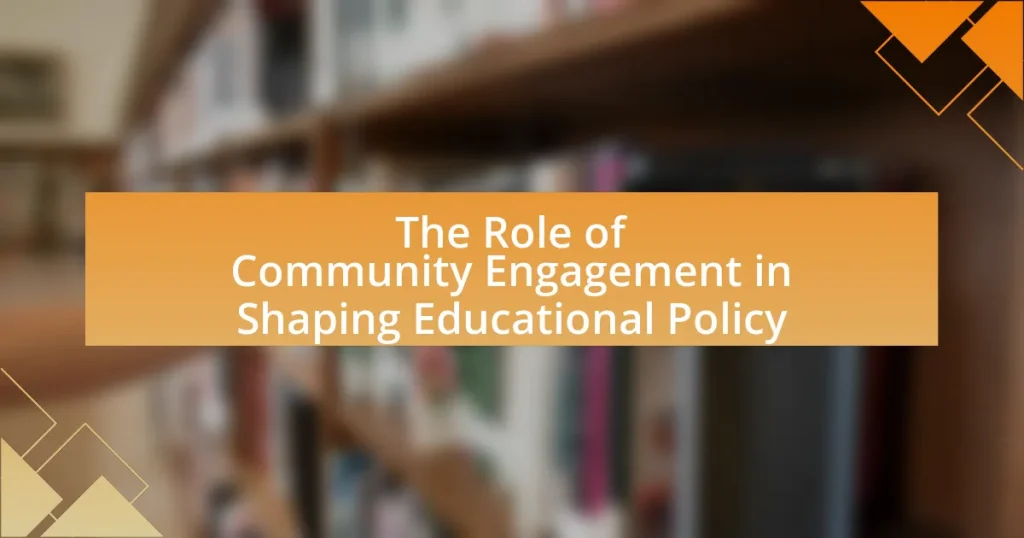The article examines the critical role of community engagement in shaping educational policy, emphasizing the importance of incorporating the voices and needs of stakeholders such as parents, students, and educators. It outlines how effective community engagement influences educational decision-making, enhances student outcomes, and fosters trust between schools and communities. Key elements of successful engagement include collaboration, communication, inclusivity, and accountability, while challenges such as lack of trust and systemic inequalities are also addressed. The article further discusses strategies for integrating community engagement into educational policy processes and highlights the benefits of active participation in improving educational initiatives.

What is the role of community engagement in shaping educational policy?
Community engagement plays a crucial role in shaping educational policy by ensuring that the voices and needs of stakeholders, including parents, students, and educators, are considered in decision-making processes. This involvement leads to policies that are more reflective of the community’s values and priorities, ultimately enhancing educational outcomes. Research indicates that when communities actively participate in policy discussions, there is a higher likelihood of successful implementation and support for educational initiatives, as evidenced by studies showing improved student performance in schools with strong community ties.
How does community engagement influence educational decision-making?
Community engagement significantly influences educational decision-making by ensuring that the perspectives and needs of stakeholders, such as parents, students, and local organizations, are incorporated into policy development. This involvement leads to more relevant and effective educational strategies, as evidenced by studies showing that schools with active community participation report higher student achievement and satisfaction rates. For instance, a report by the National Education Association highlights that schools engaging with their communities see improved trust and collaboration, which directly impacts decision-making processes and outcomes.
What are the key elements of effective community engagement in education?
The key elements of effective community engagement in education include collaboration, communication, inclusivity, and accountability. Collaboration involves partnerships between schools, families, and community organizations to enhance educational outcomes. Effective communication ensures that all stakeholders are informed and can share their perspectives, fostering transparency. Inclusivity guarantees that diverse voices, particularly those from marginalized groups, are represented in decision-making processes. Accountability establishes mechanisms for evaluating the impact of community engagement efforts, ensuring that commitments are met and stakeholders are held responsible. These elements collectively contribute to a more responsive and effective educational environment.
How do stakeholders participate in the community engagement process?
Stakeholders participate in the community engagement process by actively contributing their perspectives, resources, and expertise to inform decision-making. This involvement can take various forms, including attending public meetings, providing feedback through surveys, and collaborating in focus groups. For instance, research by the National School Boards Association highlights that stakeholder engagement leads to more effective educational policies, as it incorporates diverse viewpoints and fosters a sense of ownership among community members. This collaborative approach ensures that the policies developed are reflective of the community’s needs and priorities.
Why is community engagement important for educational policy development?
Community engagement is crucial for educational policy development because it ensures that the needs and perspectives of all stakeholders are considered. Engaging the community allows policymakers to gather diverse insights, which leads to more effective and relevant educational policies. Research indicates that when communities are involved in the policy-making process, there is a higher likelihood of successful implementation and acceptance of those policies, as seen in studies conducted by the National Education Association, which highlight the positive correlation between community involvement and student outcomes.
What benefits does community engagement bring to educational outcomes?
Community engagement significantly enhances educational outcomes by fostering collaboration between schools and local stakeholders. This collaboration leads to improved student achievement, as evidenced by studies showing that schools with active community involvement report higher graduation rates and better standardized test scores. For instance, a report by the National Education Association found that schools with strong community partnerships saw a 20% increase in student performance metrics. Additionally, community engagement promotes a supportive learning environment, which is crucial for student motivation and retention. By integrating resources and expertise from the community, educational institutions can address diverse student needs more effectively, ultimately leading to more equitable educational opportunities.
How does community engagement foster trust between schools and communities?
Community engagement fosters trust between schools and communities by creating open lines of communication and collaboration. When schools actively involve community members in decision-making processes, it leads to a shared sense of ownership and accountability. Research indicates that schools with strong community ties experience higher levels of parental involvement, which correlates with improved student outcomes. For instance, a study by the Harvard Family Research Project found that effective family and community engagement strategies can enhance trust and lead to better educational policies that reflect the needs of the community. This mutual investment in education builds a foundation of trust, as stakeholders see their input valued and acted upon.
What challenges exist in implementing community engagement in educational policy?
Implementing community engagement in educational policy faces several challenges, including lack of trust between stakeholders, insufficient resources, and varying levels of community interest and involvement. Trust issues often arise from historical inequities in education, leading to skepticism about the intentions of policymakers. Additionally, limited financial and human resources can hinder effective engagement efforts, making it difficult to organize and sustain community participation. Furthermore, disparities in community interest can result in uneven engagement, where some groups are more active than others, complicating the policy-making process. These challenges are documented in studies such as “Community Engagement in Education: A Review of the Literature” by the National Education Association, which highlights the importance of addressing these barriers to foster meaningful collaboration.
What barriers do communities face in participating in educational policy discussions?
Communities face several barriers in participating in educational policy discussions, including lack of access to information, limited representation, and systemic inequalities. Access to relevant information is often restricted, making it difficult for community members to engage meaningfully; for instance, complex policy documents may not be available in accessible formats. Limited representation occurs when certain demographics, particularly marginalized groups, are underrepresented in discussions, leading to a lack of diverse perspectives. Systemic inequalities, such as socioeconomic disparities, can further hinder participation by creating obstacles like time constraints and financial limitations that prevent individuals from attending meetings or engaging in advocacy efforts. These barriers collectively diminish the effectiveness of community engagement in shaping educational policy.
How can these challenges be overcome to enhance community involvement?
To overcome challenges and enhance community involvement in shaping educational policy, it is essential to implement inclusive communication strategies that actively engage diverse community members. Research indicates that when educational institutions utilize platforms for open dialogue, such as town hall meetings and online forums, participation increases significantly. For instance, a study by the National School Boards Association found that districts employing regular community engagement initiatives saw a 30% rise in stakeholder involvement. Additionally, providing training and resources for community leaders can empower them to facilitate discussions and advocate for their constituents effectively, further bridging gaps between policymakers and the community.
How can community engagement be effectively integrated into educational policy processes?
Community engagement can be effectively integrated into educational policy processes by establishing structured platforms for collaboration between policymakers, educators, and community members. These platforms, such as advisory councils or community forums, facilitate open dialogue and ensure that diverse perspectives are considered in decision-making. Research indicates that when community members actively participate in policy discussions, the resulting policies are more relevant and responsive to local needs, as evidenced by the National Education Association’s findings that inclusive practices lead to improved educational outcomes.
What strategies can schools use to promote community engagement?
Schools can promote community engagement by implementing strategies such as establishing partnerships with local organizations, hosting community events, and creating advisory boards that include community members. These strategies facilitate collaboration and communication between schools and the community, fostering a sense of shared responsibility for student success. For instance, research by the National Education Association indicates that schools with strong community partnerships see improved student outcomes and increased parental involvement, demonstrating the effectiveness of these engagement strategies.
How can technology facilitate community engagement in education?
Technology facilitates community engagement in education by providing platforms for communication, collaboration, and resource sharing among educators, students, and community members. For instance, online forums and social media enable stakeholders to discuss educational policies and initiatives, fostering a sense of community involvement. Research shows that schools utilizing technology for community engagement report increased participation rates; a study by the National School Boards Association found that 73% of school leaders believe technology enhances communication with families and the community. Additionally, tools like virtual town halls and webinars allow for broader participation, ensuring diverse voices are heard in the decision-making process.
What are the best practices for fostering community engagement in educational policy?
The best practices for fostering community engagement in educational policy include establishing clear communication channels, involving diverse stakeholders, and creating collaborative decision-making processes. Clear communication ensures that community members are informed about policy changes and can provide input, while involving diverse stakeholders, such as parents, teachers, and local organizations, enriches the dialogue and reflects the community’s needs. Collaborative decision-making processes, such as public forums and advisory committees, empower community members to actively participate in shaping policies. Research indicates that districts employing these practices see increased trust and participation from the community, leading to more effective educational policies.
How can schools measure the effectiveness of their community engagement efforts?
Schools can measure the effectiveness of their community engagement efforts through surveys, participation rates, and feedback mechanisms. Surveys can assess community perceptions and satisfaction levels regarding school initiatives, while participation rates in events and programs indicate community involvement. Additionally, feedback mechanisms, such as focus groups or community forums, provide qualitative insights into the impact of engagement efforts. Research shows that schools with higher community engagement report improved student outcomes and stronger relationships with families, highlighting the importance of these measurement strategies.
What role do community leaders play in shaping educational policy through engagement?
Community leaders play a crucial role in shaping educational policy through engagement by acting as intermediaries between the community and educational institutions. They facilitate dialogue, gather input from diverse stakeholders, and advocate for the needs and priorities of the community, ensuring that educational policies reflect local values and requirements. For instance, studies have shown that when community leaders actively participate in school board meetings and policy discussions, there is a higher likelihood of policies being implemented that address specific community challenges, such as resource allocation and curriculum relevance. This engagement not only empowers community members but also enhances the accountability of educational institutions to the populations they serve.
What practical steps can communities take to engage with educational policy effectively?
Communities can engage with educational policy effectively by organizing forums and discussions to gather input from diverse stakeholders. These forums allow parents, teachers, and students to voice their concerns and suggestions, fostering a collaborative environment. Research indicates that community involvement in educational decision-making leads to improved student outcomes and greater accountability in schools. For instance, a study by the Harvard Family Research Project found that schools with strong community engagement saw a 10% increase in student achievement. Additionally, communities can form coalitions to advocate for specific policy changes, ensuring that their collective voice is heard in local government meetings. This strategic approach not only amplifies their concerns but also builds relationships with policymakers, enhancing the likelihood of successful advocacy.



